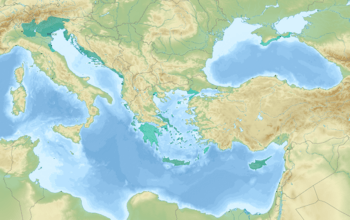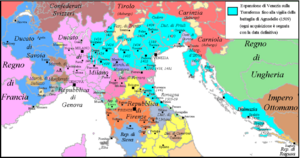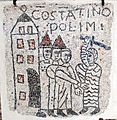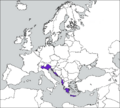Republic of Venice facts for kids
Quick facts for kids
Most Serene Republic of Venice
|
|||||||||||||
|---|---|---|---|---|---|---|---|---|---|---|---|---|---|
| 697–1797 | |||||||||||||
|
Motto: Pax tibi Marce, evangelista meus
"Peace be to you Mark, my evangelist" |
|||||||||||||

Diachronic map of the Republic and the Venetian Empire.
|
|||||||||||||
| Capital | Eraclea (697–742) Malamocco (742–810) Venice (810–1797) |
||||||||||||
| Common languages | |||||||||||||
| Government | Parliamentary oligarchic merchant republic with elective monarchistic features | ||||||||||||
| Doge | |||||||||||||
|
• 697–717 (first)
|
Paolo Lucio Anafestoa | ||||||||||||
|
• 1789–1797 (last)
|
Ludovico Manin | ||||||||||||
| Legislature | Great Council | ||||||||||||
|
• Upper Chamber
|
Senate | ||||||||||||
|
• Lower Chamber
|
Council of Ten | ||||||||||||
| Historical era | Middle Ages – Early modern period | ||||||||||||
|
• Established1
|
697 | ||||||||||||
|
• Golden Bull of Alexios I
|
1082 |
||||||||||||
| 1177 | |||||||||||||
|
• Sack of Constantinople
|
1204 | ||||||||||||
|
• Battle of Motta
|
1412 | ||||||||||||
| 1571 | |||||||||||||
|
• Treaty of Passarowitz
|
1718 | ||||||||||||
| 1797 | |||||||||||||
| Currency | Venetian ducat Venetian lira |
||||||||||||
|
|||||||||||||
| Today part of | Italy Slovenia Croatia Montenegro Albania Greece Cyprus Turkey Ukraine |
||||||||||||
|
a. ^ Paolo Lucio Anafesto is traditionally the first Doge of Venice, but John Julius Norwich suggests that this may be a mistake for Paul, Exarch of Ravenna, and that the traditional second doge Marcello Tegalliano may have been the similarly named magister militum to Paul. Their existence as doges is uncorroborated by any source before the 11th century, but as Norwich suggests, is probably not entirely legendary. Traditionally, the establishment of the Republic is, thus, dated to 697 AD.
|
|||||||||||||
The Most Serene Republic of Venice (Italian: Serenissima Repubblica di Venezia, Venetian: Republica de Venesia) was an important state in Italy. It was located where the city of Venice is today.
This powerful republic existed for over 1,100 years. It started in the late 7th century and lasted until the late 18th century. In 1797, it was taken over by Napoleon. Venice was a major player in trade and economics. It was led by a special ruler called a doge.
Contents
What Was the Republic of Venice?
The Republic of Venice was a unique kind of state. It was known as a merchant republic. This meant that trade and business were super important to its power. It was also an oligarchy, which means a small group of wealthy families held most of the power.
How Venice Was Governed
Venice had a special system of government. It was led by a doge, who was elected for life. However, the doge was not a king with absolute power. His power was limited by various councils.
- The Great Council was the main governing body. It was made up of noble families.
- The Senate handled foreign policy and important decisions.
- The Council of Ten was a powerful group that kept an eye on the doge and made sure laws were followed.
This system helped keep power balanced and prevented any one person from becoming too strong.
How Venice Became a Powerhouse
Venice's location was perfect for trade. It was built on islands in a lagoon, which made it easy to defend. It also gave Venice great access to the Adriatic Sea and the wider Mediterranean Sea.
Venice became rich by controlling trade routes. Its ships carried goods like spices, silks, and precious metals. They traded with the Byzantine Empire, the Middle East, and other parts of Europe. To protect its trade, Venice built a strong navy. Its warships were some of the best in the world.
Key Moments in Venetian History
- 1082: Venice gained special trading rights from the Byzantine Empire. This helped them become even richer.
- 1204: Venetian ships played a big role in the Sack of Constantinople. This event weakened the Byzantine Empire and gave Venice more control over trade in the East.
- 1571: Venice joined other European powers in the Battle of Lepanto. They defeated the Ottoman fleet, showing their naval strength.
The End of the Republic
After centuries of power, Venice began to decline. New trade routes were discovered, and other European nations grew stronger. By the late 18th century, Venice was not as powerful as it once was.
In 1797, Napoleon Bonaparte and his French army invaded Italy. Napoleon conquered Venice, ending its long history as an independent republic. The Treaty of Campo Formio officially dissolved the Republic of Venice. Its lands were divided among other European powers.
Venice's Legacy Today
Even though the Republic of Venice no longer exists, its influence is still seen today. The city of Venice is a famous tourist destination. Its unique architecture, canals, and art are a reminder of its glorious past. Many of the places that were once part of the Venetian Empire are now countries like Italy, Slovenia, Croatia, Greece, and Cyprus.
Images for kids
-
The Doge of Venice, illustrated in the manuscript Théâtre de tous les peuples et nations de la terre avec leurs habits et ornemens divers, tant anciens que modernes, diligemment depeints au naturel. Painted by Lucas d'Heere in the 2nd half of the 16th century. Preserved by the Ghent University Library.
-
The sack of Constantinople in 1204 on a mosaic in the San Giovanni Evangelista church in Ravenna, 1213
-
Leonardo Loredan, Doge of Venice during the War of the League of Cambrai.
-
The Venetian fort of Palamidi in Nafplion, Greece, one of many forts that secured Venetian trade routes in the Eastern Mediterranean.
-
Siege of Tyre (1124) in the Holy Land
-
Voyage of Marco Polo into the Far East during the Pax Mongolica
-
The Piraeus Lion in Venice, in front of the Venetian Arsenal
-
Relief of the Venetian Lion on the Landward Gate in Zara (Zadar), capital of the Venetian Dalmatia
-
Vicenza, Piazza dei Signori.
-
Udine, Piazza Libertà.
-
Relief of the Venetian Lion in Cattaro (Kotor)
-
Relief of the Venetian Lion in Candia (Heraklion)
-
Relief of the Venetian Lion in Frangokastello, Crete
-
Venetian blazon with the Lion of Saint Mark, as frequently found on the New Fortress walls, Corfu.
See also
 In Spanish: República de Venecia para niños
In Spanish: República de Venecia para niños
























